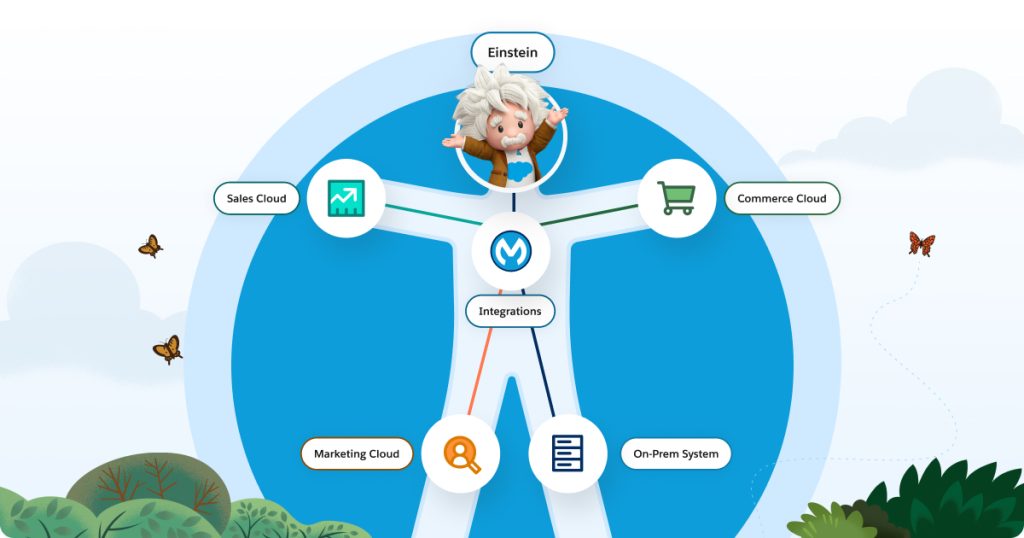Recent developments in generative and predictive AI indicative that it’s set to become the biggest technological advancement ever.
One of the biggest impacts to both organizations and customers is combining the power of artificial intelligence with the immense amount of data that exists. With AI, the expectation is that a company must provide a next-level customer experience.
Having AI models and data alone can’t necessarily provide an excellent customer experience. Data must be available for the AI models at the right time, in the right manner, and with the right controls in order to deliver the experience end-users are seeking. Put differently: it’s integrating data that is central to deriving the most out of your AI.
Why is integrating data important?
Organizations find themselves relying on a vast array of applications – around 1000 – each serving a specific purpose in the intricate tapestry of their operations. Surprisingly, despite the abundance of tools, a staggering 70% of these applications remain disconnected from one another, and more crucially, from core business processes, disrupting the potential for efficiency across the organization.
Additionally, consider the sheer magnitude of untapped data within these isolated silos. A wealth of information remains inaccessible to your teams and advanced LLMs and machine learning models are left incapable of delivering high-value insights or recommendations.
The prevailing scenario can be likened to the age-old adage “garbage in, garbage out”. But in this era dominated by AI, a more fitting phrase emerges: “missing data, missing insights”.
In a world that is beginning to heavily rely on AI for decision-making, the consequences of disjointed data become glaringly evident. The absence of a holistic view across applications not only stifles the effectiveness of AI algorithms but also jeopardizes the accuracy and relevance of the insights they provide.
As organizations grapple with this challenge, the need for cohesive data integration becomes more critical than ever. With customer expectations reaching new heights, the repercussions of missing data and insights can eventually lead to a new adage: missing data, missing insights, poor customer satisfaction, and higher customer attrition.
Weaving your data together with integrations
Consider your enterprise infrastructure as an interconnected system, all depending on each other in a continuous cycle. Much like a human body, enterprise systems are reliant on every other part of the structure — one is only as strong as its weakest part.
Picture the limbs (your hands and legs) as the diverse array of applications and CRM clouds that serve specific functions within your organizational framework. These limbs are not just independent entities; rather, they are the operational extensions that collectively contribute to the overall capability of the organization. Information flows through these limbs, akin to signals from nerve endings, and it’s this data that fuels the cognitive functionality within the organizational brain – manifesting in advanced processes such as AI-driven decision-making.
However, for this organizational body to truly function seamlessly and efficiently, there must be an equivalent to the central nervous system — a vital integration layer. This integration layer serves as the organizational backbone, linking the disparate functions of the “limbs” to the cognitive capabilities of the “brain.” Much like the central nervous system orchestrates communication between the limbs and the brain in a human body, the integration layer facilitates the harmonious flow of data between various applications, ensuring that the organization operates as a unified, cohesive entity.
Just as disruptions in the central nervous system can impede the optimal functioning of the human body, the lack of a robust integration layer within enterprise systems can result in inefficiencies, missed opportunities, and a failure to capitalize on the full potential of available data.
In this analogy, the integration layer becomes not just a technological necessity but a strategic imperative, a fundamental component ensuring that the entire organizational body moves in concert, leveraging its collective strength to navigate the complexities of the business landscape.

Similar to the central nervous system, integrating data is one of the important components — if not the most important component — in building a successful AI strategy. As organizations start to deploy their data, they can use out-of-the-box integrations or leverage the ability to build and bring their own. To leverage data, after all, you need to integrate it. However, AI is only as good as the data that is used to ground it.
Here are four key aspects of integrating data you must consider when it comes to AI.
Data freshness
Traditionally, integration has evolved from overnight batches to periodically scheduled batches. Further evolution resulted in asynchronous, near real-time integrations. With immense amounts of data and the timeliness (or lack thereof), even near real-time can fall short.
Imagine your customer placing an order and immediately calling to correct their contact number. The call center agent may not have access to the order that was placed just a minute ago. We need to break the barrier of near real-time data integration even further. How do you provide AI with the latest and greatest data to generate the most relevant and up-to-date insights?
Preventing redundancy
As you integrate and move data from one source to another, it creates multiple copies of data and also creates data quality issues. It will be challenging to keep up with data that is frequently changing and having an impact on your AI-driven predictions and recommendations.
Best case scenario? You’ll have a huge amount of data as you integrate every change in the source system. Worst case scenario? You’ll miss key data updates, which will negatively impact your insights.
As an alternative, you should consider how you can get access to data without managing multiple copies of it. Could data virtualization solutions be an answer in this scenario?
Revamped security
In the world of AI, integration security requires thinking beyond traditional challenges like blocking bad actors and preventing unauthorized access. The sheer volume of data and scenarios handled by AI models poses new threats like introducing bias due to prioritizing one data source over another.
Traditional measures like SSO, MFA, allow/deny list, and so on will fall short against increasingly sophisticated threats and will require new ways of securing your integrations and data. You’ll need to think about introducing additional controls to proactively monitor, detect, and block these threats.
Governance
New ways of integrating and securing data for AI use cases will require a fresh perspective on integration governance. It requires well-thought-through policies and procedures to connect AI technologies to your existing systems, workflows, and business processes.
The goal of integration governance is to minimize risk and ensure compliance with evolving regulatory and ethical requirements. It will also require revising existing vendor management and monitoring and auditing policies to align with your revised governance practices.
AI is powered by a strong integration strategy
Data can transform what you can do with AI. So consider the importance of building your AI strategy alongside your integration strategy to avoid future challenges, like inaccurate and siloed data, exposed security vulnerabilities, or a lack of governing processes when issues arise. Don’t let the integration layer become a barrier to getting the most out of your AI.









